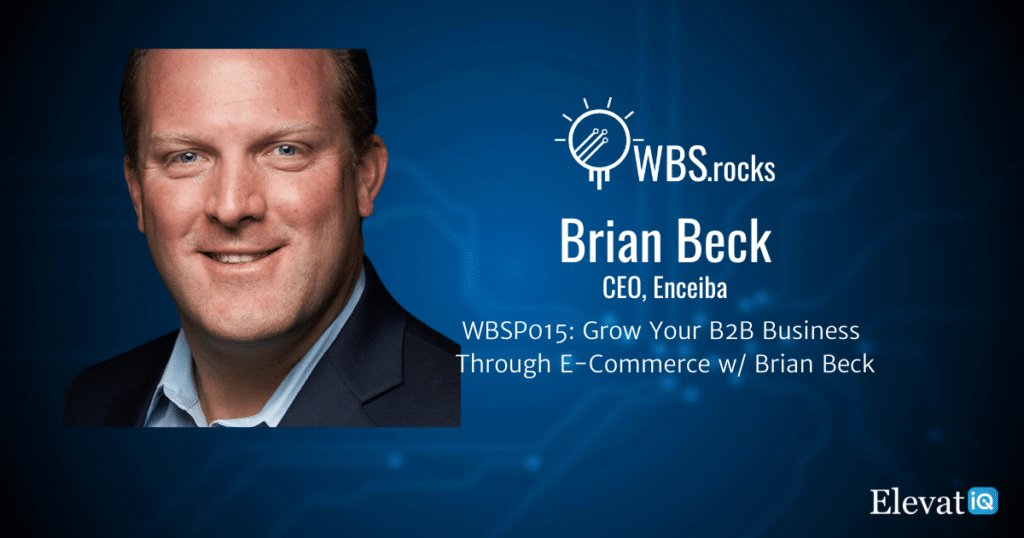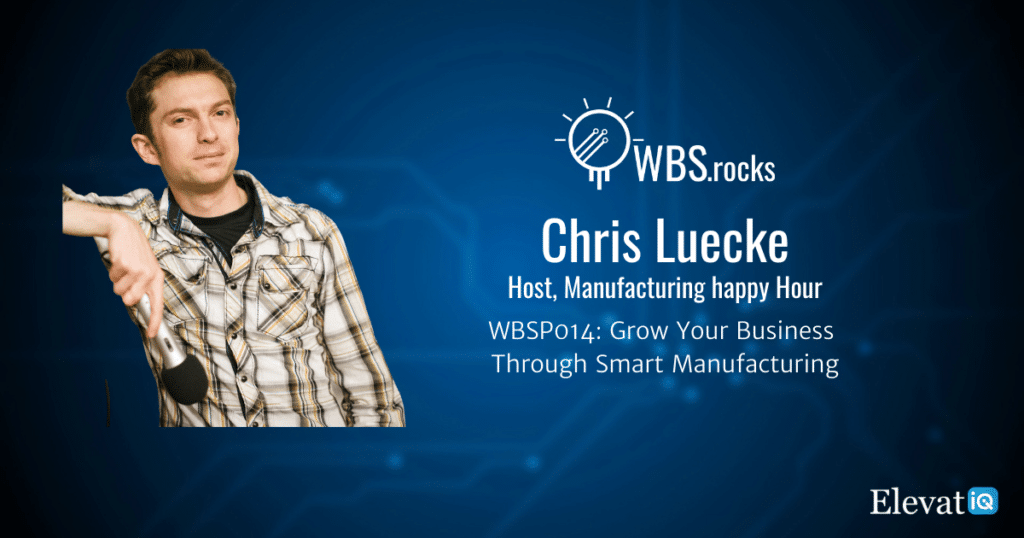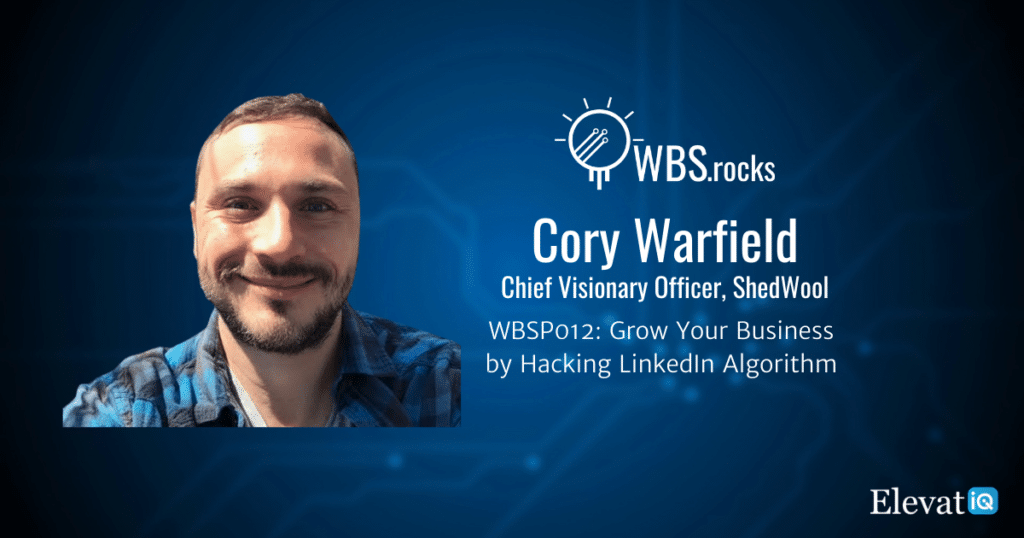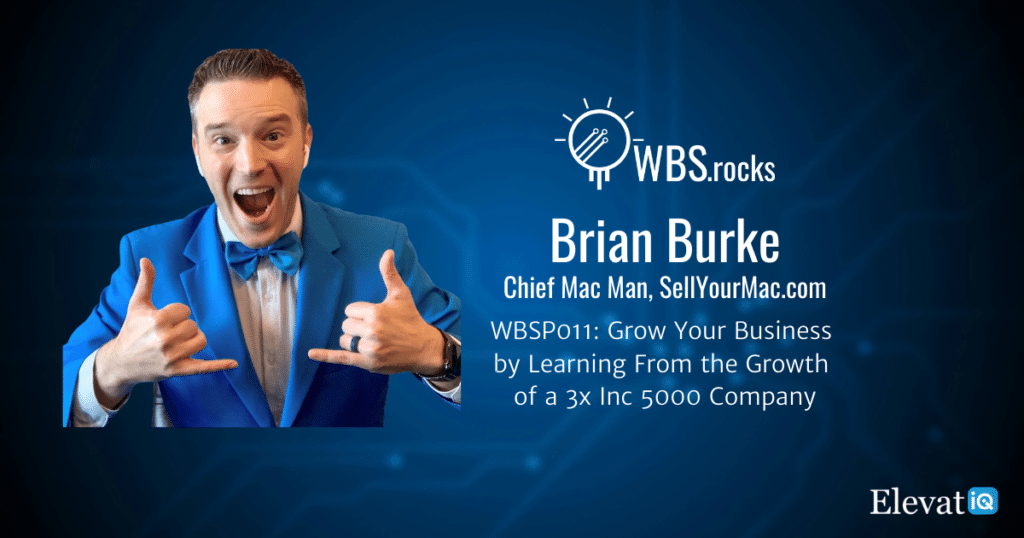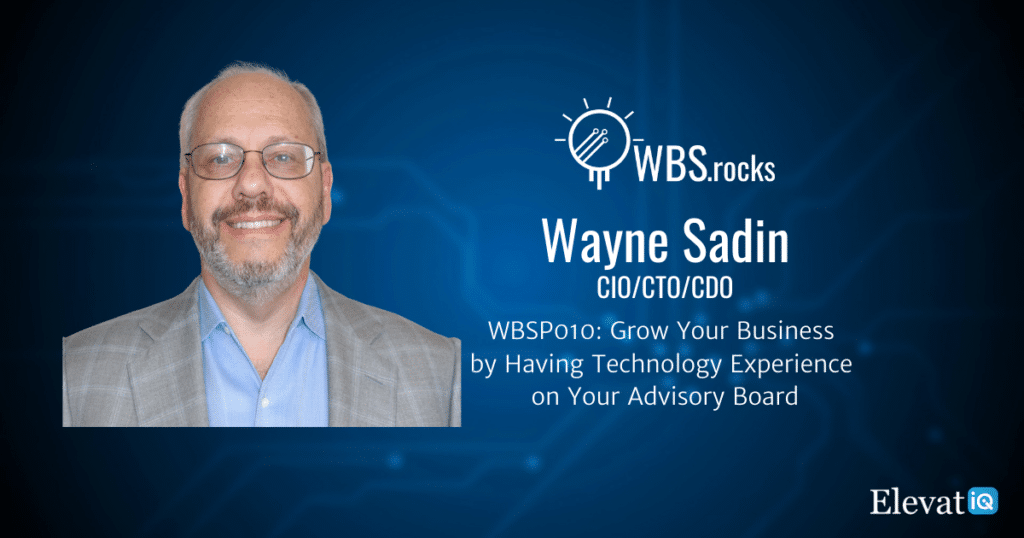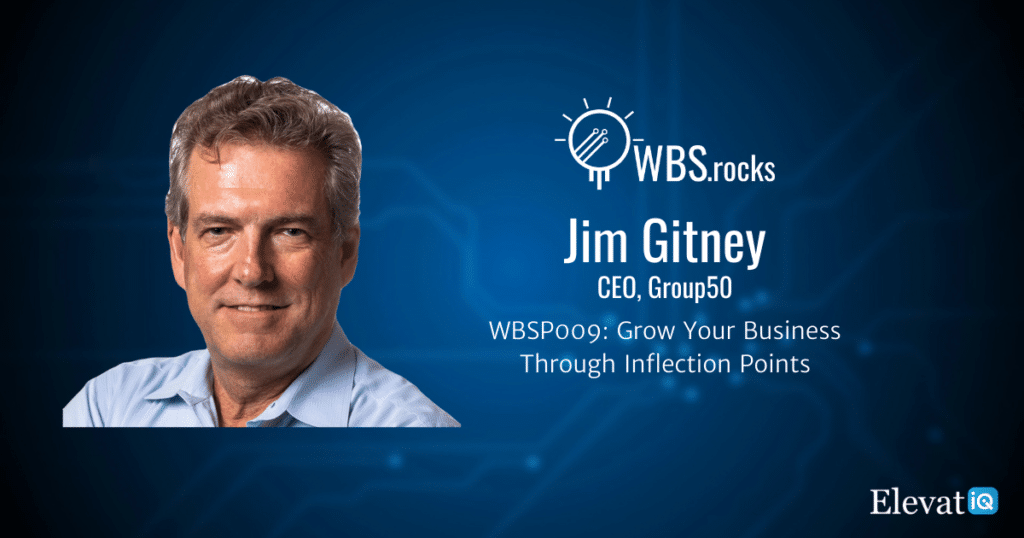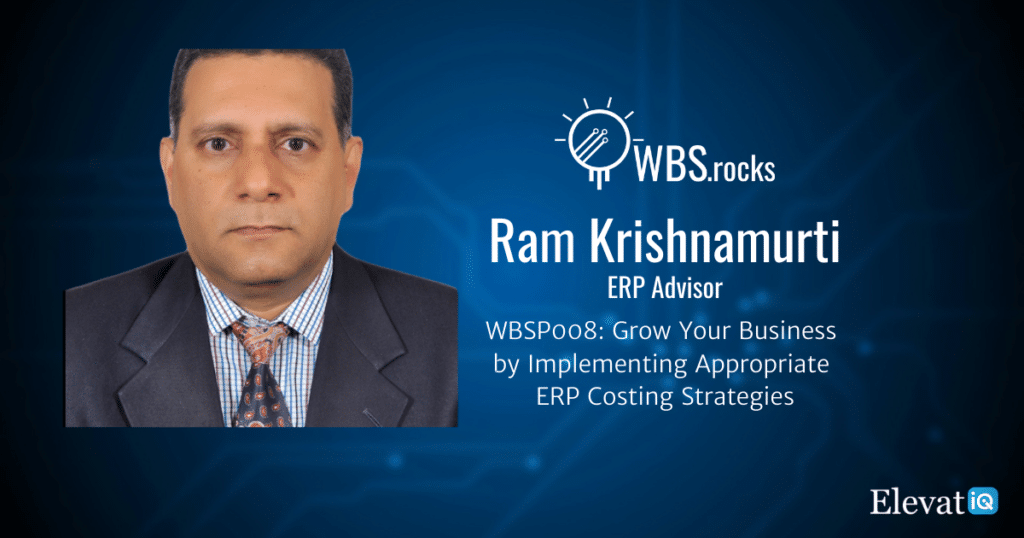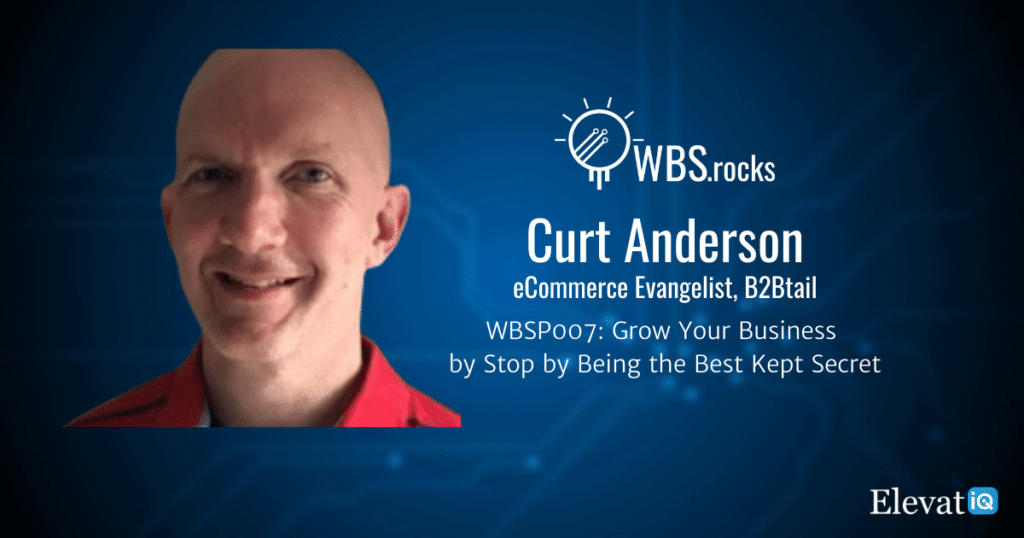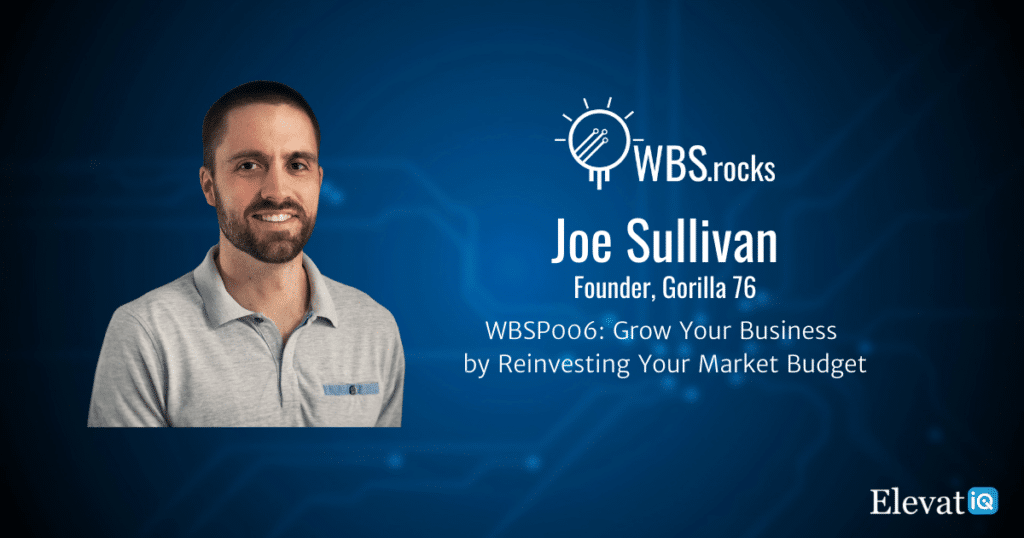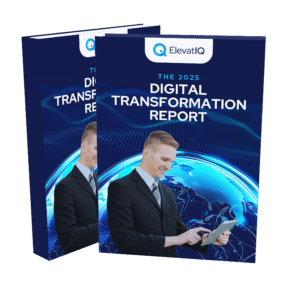WBSP015: Grow Your B2B Business Through E-Commerce w/ Brian Beck
In this episode, we have our guest Brian Beck from Enceiba, who discusses key trends in B2B e-commerce, including the rise of Amazon’s prominence in B2B product research and buying, and why manufacturers and distributors should be paying attention and acting now.
We also touched on the digital transformation landscape for B2B e-commerce businesses, and how CEOs can begin their journey of e-commerce enablement. If you are looking for research-based insights from an industry expert, long-time practitioner, and author who spent 4 years interviewing your peers and competitors, this episode is a must-listen for you.
Chapter Markers
- [0:00] Intro
- [2:55] Personal journey and current focus
- [8:07] Perspective on growth
- [11:15] how COVID is going to change B2B E-commerce?
- [14:47] How is B2B E-commerce different from B2C?
- [19:18] Difference between B2B e-commerce versus B2B Commerce
- [24:15] How big is B2B E-commerce opportunity?
- [27:58] Is Amazon a threat to manufacturers and distributors?
- [31:48] B2B E-commerce platform selection process
- [34:10] Closing thoughts
- [39:40] Outro
Key Takeaways
- Within three or four years, by 2025, 75% of the B2B buyers are going to be millennials, who are Amazon natives, digital natives; they use Amazon for almost 100% of their online shopping. So these folks are coming to your website with an expectation that you’re going to deliver. And if you’re not, those customers are looking elsewhere.
- Once you show people that this is an easier path or and saves them time and, in some cases money, to use e-commerce, they’re not going back. They’re going to stick with e-commerce because, particularly in B2B, if you make the buyers’ job easier, they’re going to continue that behavior.
- At the end of 2021, we’re still going to have 30% of the workforce here in the US working remotely 30%. That means that’s 30%; you’re not going to go show up at someone’s house to sell them a product. You have to reach them digitally.
- Amazon is getting 70% of product search where, in other words, where the product search starts. So people kick open their browser, and they, five years ago, they would go to Google and type in a product name. That behavior has now shifted 70% of it to Amazon. And if you look at Amazon’s B2B business, it has become the fastest-growing part of Amazon.
- Amazon is selling if you look at where they’re making progress; it’s in things like MRO, industrial products, medical dental. Last year, Amazon and the medical and dental space did over $2 billion in revenue. And this is not just over-the-counter stuff. If you’re in the medical field, we’re talking about regulated type II, class II medical devices, which the FDA regulates. Amazon is putting in workflows to accommodate this.

Subscribe and Review
Apple | Spotify | Stitcher | Google Podcasts | Deezer | Player FM | Castbox
About Brian
Brian Beck has 20+ years of experience, including more than a decade as a hands-on C-level Ecommerce executive. Brian currently serves as the Managing Partner of Enceiba, the industry’s only Amazon consultancy focused on serving the B2B industry, and he is the author of the first comprehensive book on B2B Ecommerce, entitled “Billion Dollar B2B Ecommerce”.
Resources
Full Transcript
Brian Beck 0:00
So I think the long-term impact number one is increased adoption, and it’s accelerated. You know, we’ve seen ten years of acceleration in eight months in the B2B e-commerce field.
Intro 0:13
Growing a business requires a holistic approach that extends beyond sales and marketing. This approach needs alignment among people, processes, and technologies. So if you’re a business owner, operations, or finance leader looking to learn growth strategies from your peers and competitors, you’re tuned into the right podcast. Welcome to the WBS podcast, where scalable growth using business systems is our number one priority.
Now, here is your host, Sam Gupta.
Sam Gupta 0:50
Hey everyone, welcome back to another episode of The WBS podcast. I’m Sam Gupta, your host, and principal consultant at a digital transformation consulting firm, ElevatIQ.
Traditionally, B2B businesses have been relationship-based. However, in the modern digitally centered buying process, 70% of the buyers now fully define their needs on their own before engaging with a sales representative. B2B businesses need to critically review their go-to-market strategy before it’s too late. COVID has further fueled the rise of e-commerce. Also, with Facebook buying Kustomer, we will see a convergence of B2B and B2C. And marketplaces such as Amazon will play a key role in the success of B2B businesses.
In today’s episode, we have our guest Brian Beck from Enceiba, who discusses key trends in B2B commerce, including the rise of Amazon’s prominence in B2B product research and buying, and why manufacturers and distributors should be paying attention and acting now. We also touched on the digital transformation landscape for B2B e-commerce businesses and how CEOs can begin their journey of e-commerce enablement. If you’re looking for research-based insights from an industry expert, longtime practitioner, and author who spent four years interviewing your peers and competitors, this episode is a must-listen for you.
Let me introduce Brian to you.
Brian back has 20 plus years of experience, including more than a decade as a hands-on C-Level ecommerce executive. Brian currently serves as the managing partner of Enceiba, the industry’s only Amazon consultancy focused on serving the B2B industry. And he is the author of the first comprehensive book on B2B e-commerce entitled Billion-dollar B2B E-commerce.
With that, let’s get to the conversation.
Hey, Brian, welcome to the show.
Brian Beck 2:52
Hey, Sam. I’m glad to be here. Thanks so much for having me.
Sam Gupta 2:55
Okay, amazing. I’m super excited to have you as well. So to kick things off, do you want to start with your personal story? What are you focusing on these days?
Brian Beck 3:04
Yeah, no problems. And well, hey, again, thanks for having me. So yes, I’m a 20 year veteran in the e-commerce field. I’ve been an executive in charge of e-commerce and a CEO and COO at companies throughout the e-commerce field.
Most of my career was spent as an e-commerce expert for retail and consumer brands. And Sam, I got into the e-commerce field for B2B about five years ago, advising companies on how to develop their e-commerce and digital transformation efforts for companies. Again, the kind of B2B manufacturers and distributors folks who have had no real history in selling or leveraging digital to reach their customers.
And, Sam, when I got into doing this, I was asked by my clients, hey, is there a place I can go to read about these? How to do this? And Gosh, I couldn’t find anything.
So I decided foolishly to write a book.
Sam Gupta 4:17
Okay, you are being super humble here. And by the way, you mentioned 20 years veteran. When I talk to book authors, typically, that’s going to be 4 times as much experience. So, in my mind, you are an 80-years veteran.
Brian Beck 4:26
Thank you, Sam. Yes, I ran e-commerce for several companies and successfully built some companies’ e-commerce efforts to over $100 million in revenue. And so I did some things right, I guess. And I wanted to put that into writing. Because what I realized was that, without a resource, like a book, people didn’t have a good foundation. So I basically wrote my 18 years.
Brian Beck 5:09
So the book is called billion dollar B2B e-commerce. And it’s 100 pages long. It’s 12 chapters. But it’s every element that a B2B company needs to build its digital transformation. It’s everything from the leadership and organizational elements required to manage channel conflict, align your selling channels, and make sure your sales forces align with what you’re doing in e-commerce.
It also includes building a technology foundation. This effort requires investment in technology to do this well. And then how to market and how to deal with and manage your presence on marketplaces like Amazon. And how to adopt the principles of B2C e-commerce for B2B success.
There is so much we’ve learned Sam over the last 20 years. From our work with B2C e-commerce, there are so many best practices that have been well established now. And your B2B buyer today expects those from you.
So interesting fact, Sam. Within three or four years, I think by 2025, 75% of the B2B buyers are going to be millennials. These are people born between 1980 and 2000.
Brian Beck 6:32
These people are Amazon natives, digital natives; they use Amazon for almost 100% of their online shopping, at least a portion of it. So these folks are coming to your website with an expectation that you’re going to deliver.
And if you’re not, those customers are looking elsewhere.
So there’s a real mandate. And, frankly, this whole event with COVID has just accelerated everything that’s going on in the market. So, it’s a mandate; it’s a call to action. And, the book, I didn’t time it this way. But when it came out earlier this year, Sam, it’s been a resource for a lot of companies. I get calls from these companies, and their whole executive team has read the book, and they’ve got it all your marketing, got post-it notes sticking out, and it’s great. And I am grateful and thankful that people have found a lot of use for this book. So anyway, there’s a lot of concepts in there.
So I love to dive in on whatever you want to Sam.
Sam Gupta 8:07
We are super hungry for growth as millennials. Okay, so the next question, and we follow this ritual here, asked every guest that we get on the show. So what is your perspective on growth?
Brian Beck 8:29
Well, gosh, it’s the whole subject of the, what I wrote about it, growth, the digital has become the center of everything. And is the key to growing a business these days. And I talk about this not only from the standpoint of digital enablement for commerce because that’s important. But it’s also if you think about, particularly with COVID, the physical doors being locked, you’ve got to enable the sales team as well digitally.
So if you’re a B2B company, the mandate for digital as the driver for growth just got a lot louder. So when you think about the return on investment, the ROI, right from an investment in digital commerce and digital enablement, a lot of it is about meeting that need. It comes from places like incremental revenue from e-commerce, obtaining more share of wallets from existing customers, and capturing new markets by leveraging e-commerce.
Brian Beck 9:36
I’ve got several case studies in the book that talk about companies of all sizes ranging from smaller companies $10-20 million in revenue to multi-billion dollar enterprises. The companies that have captured more revenue and entered new markets using e-commerce, finding customers niches they’ve never had before. And in doing so, through reaching out in e-commerce, you know, being found, for example, in Google.
I have one case study in there of a distributor, for example, that almost doubled the size of its business leveraging e-commerce. Why? Because they’re getting new customers from Google searches that are finding them in more geographic markets, they historically never served. We’ve got another case study of a manufacturer that is achieving millions in new revenue by reaching beyond the OEMs. This company, in particular, makes metrics, measurement tools. They’ve always sold to Boeing and all these big OEMs. They’re reaching into new markets.
They started selling their products to bicycle shops because they had no idea that these people could use their products, but now they’re finding them on Google. And these are hard to find tools.
So it’s real growth, Sam. To get to your question growth is, is now is digitally enabled. And so whether that’s ecommerce or helping your sales team reach customers because they can’t get into C-Suite people due to COVID and other things. It’s drives growth for you. If you do it right, and that’s what I talk a lot about, how to do it right.
Sam Gupta 11:15
You mentioned that you had done 100 interviews with the executives, and you have tons of case studies. So the amount of insight that that book authors bring to the table is phenomenal. And it just so much learning for manufacturers and distributors.
So the next question I’m going to ask you is, and I find you guys to be predicting what will happen in the market. So from the macro perspective, what is your perspective on ecommerce? What is your perspective on how COVID is going to change the economy?
Brian Beck 12:00
Great question, Sam. I think you have that expectation now of e-commerce. And so look, there’s statistics around what COVID has done. Another most striking data I saw recently was from Forrester, which showed that the penetration of e-commerce in the United States went from 16, about 15-16%, right before COVID to over 30%. I think almost 35%.
Now, what I mean by that is the number of people using e-commerce B2C and B2B to buy products. So it’s doubled. So I think, number one, you’re seeing that customers are, are now reliant on e-commerce. The long-term implication of this is that people who were reticent to use e-commerce earlier, particularly referring to B2B buyers. A good example of this would be maybe your heating, ventilating air conditioning contractor or your electrical contractor, or people that maybe hadn’t used e-commerce in the past. They are now learning how to use e-commerce and find that it’s easier and more efficient for them to do their job in many cases.
Brian Beck 13:25
And once you show people that this is an easier path or and saves them time and, in some cases money, to use e-commerce, they’re not going back. They’re going to stick with e-commerce because look, at the end of the day, particularly in B2B, if you make the buyers’ job easier, they’re going to continue that behavior.
So I think the long-term impact number one is the fact that you’re going to see increased adoption, and it’s accelerated. We’ve seen ten years of acceleration in eight months in this B2B e-commerce field. So I think that’s one and then the other. The other big one is I think you’re going to see fewer people taking appointments and physical appointments, and that’s going to continue as well. So that means your sales force needs to continue to become digitally enabled the physical sales force.
I read a statistic, Sam, that said, at the end of 2021, we’re still going to have 30% of the workforce here in the US working remotely 30%. That means that’s 30%; you’re not going to go show up at someone’s house to sell them a product. You have to reach them digitally. So you know, it has implications for the physical Salesforce as well as the digital. So I think these are long-lasting implications.
Sam Gupta 14:47
Interesting. When I used to think about e-commerce, I always used to think, B2C just because it has the commerce word in it. But lately, when I’m interviewing my guest, and I don’t know if you know Curt Anderson. So we did an episode with him. And he is super bullish on B2B as well. In fact, nowadays, ecommerce folks are not even talking about B2C.
For me, when I think of e-commerce. I used to think that this is going to be my Shopify site where I am going to have a beautiful product. Maybe I’m going to have a cart where I can check it out. But you guys are talking about something different.
So why is B2B different from B2C as far as the e-commerce landscape goes? And why is everybody trying to push on that right now?
Brian Beck 15:37
Great questions. By the way, Curt is fantastic. He’s just super knowledgeable and amazing energy. So I’m glad to hear you’ve done some interviewing with him. So yeah, why is it different? Well, so you know, it’s a different customer. Ultimately, B2C e-commerce, which is the field I lived in for 17 years, is well-established, highly competitive, very evolved, and it’s still alive.
And well, in fact, the same kinds of things are happening there with COVID that are happening in B2B. However, the fact of the matter is that B2B e-commerce, in other words, businesses selling to a business, other businesses via digital commerce, is far behind where B2C is. Only 50% of B2B firms have e-commerce capabilities.
Brian Beck 16:31
So, I’d like to say it’s 10 to 15 years behind where B2C is, and what’s different about it that was the core question? Well, it is what’s different is that the B2B buyer number one has different goals and aims, and behaviors when they use B2B e-commerce.
The primary difference in their goal is, is it’s all about efficiency. They’re using e-commerce to get their job done, not go, shop and look, look for the next greatest look for my hairdo or my outfit or whatever. I worked in the fashion apparel space for a while, which was very much about immersion into an experience. It was about getting people to engage with a lifestyle brand and things like that. So when a consumer shops, it’s partially about efficiency, but it’s also about, you know, fun, enjoyment, and engagement in the experience of shopping.
With business-to-business e-commerce, it’s all about efficiency. You have got to get the customer to what they’re looking for quickly, give them the information they need, and allow them to check out quickly.
Brian Beck 17:37
And they also need to do things that are specific to how businesses buy. So the other key difference is not only the buyers’ intention and behavior. But it is also about the expectation and accommodating the traditional workflows they have in their business.
A good example would be that businesses often buy on credit terms. A manufacturer, for example, will extend credit terms to its distributors to buy from it, or a distributor might extend credit terms to that contractor or the medical office or whoever’s buying from them. That workflow needs to be accommodated in the e-commerce arena, which doesn’t exist in B2C in the same format. So buying on a purchase order, for example. The other big example is pricing. So in the world of B2B, many companies have contracts. They’ve negotiated pricing with their supplier, or when that supplier initiates e-commerce, they need to make sure that that pricing is reflected on the e-commerce website.
One of the key ways to kill off an e-commerce effort is if you don’t present the pricing the customer expects to see in the e-commerce effort. Guess what, don’t even bother starting. It’s not going to work. The customer needs their customized pricing through the e-commerce experience to make the purchase. So those are some of the nuances and a lot of differences, Sam, but those are some of the key areas of difference from B2C to B2B.
But, the fact of the matter is B2B e-commerce is two and a half times the size even today of B2C e-commerce. It’s enormous, and a lot of people don’t realize it.
Sam Gupta 19:18
Interesting perspective. And when we look at the B2B e-commerce term, and I am going 20 years back, to be honest. So B2B e-commerce is not new, but I think you guys are pointing to a slightly newer term here. So when I think of B2B commerce, I think of portals such as Ariba or Coupa, and I don’t know if you’re familiar with them. They used to be your supplier network enterprises used to work with them, and then they will use a bidding platform. You could have your marketplace inside the office. So how do you differentiate between B2B e-commerce versus B2B Commerce?
Brian Beck 19:58
Yeah, great question. So it’s an interesting and evolving world. So you’re talking about e-procurement, EDI, punch-outs, there’s a variety of approaches to, to traditional sort of electronic commerce. And it’s to your point it has and continues to evolve. There’s still a very significant role for those types of E-procurement systems. When we look at the world of e-commerce, it’s very closely aligned.
And I believe many of those electronic commerce formats and procurement platforms will continue to exist. In fact, they need to. In many cases, they need to integrate and plan and work with each other. So what I see happening, Sam, those traditional platforms remain a significant part of the volumes that are done between suppliers and buyers. In B2B, those are systems once they’re set up are, they can run efficiently.
Brian Beck 21:06
Often, the way companies will approach e-commerce is for a certain segment of their customer base, which particularly wants to use the e-commerce format. But at the same time, they’re using those procurement systems alongside them. So they’re not, it’s not a sort of rip and replace, it’s an addition to, in many cases, insert and in some cases, they’re integrating them, or allowing the e-commerce platform, in some cases, will integrate to and support some of those systems.
For example, suppose you’re familiar with a punch-out where a customer can order through their ERP system, leveraging their traditional purchasing past. In that case, some ecommerce platforms will enable you to support punch out and be integrated into that system so that they’re reducing some of the complexity of management. So I don’t view e-commerce as a replacement for those kinds of systems, but in fact, complementary to, and in many cases, will serve a different customer than the EDI customer or the E-procurement customer who’s buying from a supplier?
Sam Gupta 22:18
I’m going to rephrase my understanding of how I’m interpreting the e-commerce world the way you describe it. So, in my opinion, B2B ecommerce has a lot of different benefits. Because here you are trying to utilize the ROI from the Amazon Marketplace from the Google ads.
But in the case of your supplier and portals, I mean, you are basically going after your existing relationships. Yes, there could be some of the newer relationships as well, but you will not be able to generate business.
So am I accurate there in my understanding of B2B e-commerce versus B2B Commerce?
Brian Beck 22:54
That’s a great way to think about it, Sam. So you’re in a closed environment with EDI or E-procurement, as you’re describing them. And so you’re not exposing yourself, your product offerings, your company, your brand, etc., but through those sort of closed environments to reach new customers and to allow them to transact the way you’ve described it. That requires e-commerce that requires a website that people can go on to they can perhaps register or maybe not even need to register to buy from you via your e-commerce website.
And so yeah, it’s a way to reach into new customer segments that the case study I alluded to earlier, the company that is now selling to bike shops, they reach them through Google searches. And that other distributor I referred to, you know, their new customers are coming through Google searches on SEO. The same thing can happen with Amazon. If you have a well-functioning Amazon presence, people are searching on Amazon more than ever and increasingly B2B. So you’ve got another whole sort of platform there as well that allows you to reach new customers. So a lot of it is about exposing more of to exposing your product catalog and your brand to new customer segments.
Sam Gupta 24:15
And it’s kind of interesting how you put this because even Curt talks about the same thing. He is super bullish on the marketplaces. He’s super bullish on Amazon. And in fact, I’m going to connect this with the recent story that Facebook just bought the new CRM platform called Kustomer. So I guess they are probably trying to get some of that B2B revenue and the ad revenue as well because everybody’s trying to jump into this marketplace boom. So to me, these marketplaces are going to be the next Google, especially for B2B.
Brian Beck 24:49
I mean, it’s not even going to be Sam. They already are. So a couple of stats for you. If you look at Amazon and their division, called Amazon business. Amazon has become the number one place people go to search for products. And this is increasingly in B2B. Amazon is getting 70% of product search where, in other words, where the product search starts. So people kick open their browser, and they, five years ago, they would go to Google and type in a product name.
Well, that behavior has now shifted 70% of it to Amazon. And if you look at Amazon’s B2B business, it has become the fastest-growing part of Amazon. I’m talking about all of that, including Amazon Web Services that it surpassed earlier in 2020. In terms of growth rate, Amazon B2B transactions are projected to be the latest numbers I’ve seen, over $70 billion by 2023. That’s three years from now. That makes them seven times the size of Grainger, which is recognized as one of the largest distributors in the world. Amazon’s going to be seven times their current size.
Brian Beck 26:16
Okay. And guess what, it’s not all office products. Amazon is selling if you look at where they’re making progress; it’s in things like MRO, industrial products, medical dental. Last year, Amazon and the medical and dental space did over $2 billion in revenue. $2 billion, folks, and this is not just over-the-counter stuff, too. If you’re in the medical field, we’re talking about regulated type II, class II medical devices, which the FDA regulates. Amazon is putting in workflows to accommodate this. So, you know, Sam, why marketplaces? Why is Amazon? Why are these other folks, you know, why they are growing so quickly?
Well, frankly, it’s that the marketplaces do a better job than most companies do with e-commerce. They provide more products and an easy experience. Also, they do the things I’m talking about related to ease of purchase, removing friction, getting the customer in and out quickly. And they are meeting the need of that millennial buyer. I mentioned there already, you know, in the case of Amazon, those buyers are already using the platform for their personal consumption. They’re just shifting over to business. So look, this is, you know, a marketplace strategy. I always tell my clients this. You have to have a marketplace, particularly Amazon’s strategy, whether you’re a market, whether you’re a manufacturer or a distributor. The implications are different. But you know, having that strategy is critical. We spend our time helping folks, that Amazon strategy because it’s not easy. I mean, there are a lot of things you have to think about as you approach a marketplace.
Sam Gupta 27:58
I find this whole Amazon thing very interesting, especially when I hear in the news that you need to be careful of Amazon. The mom-and-pop shops are gone because Amazon is just too big and too powerful. But here, actually, the sense I’m getting is it’s the exact opposite story because Amazon is opening the door for you. You come here, hang out on my premises, and make money. So it’s exactly the opposite. Amazon is actually trying to help.
Brian Beck 28:27
I think Amazon would say, look, we enable business. We enable a lot of mom-and-pop businesses, and that’s very true. I talk to people all the time who have built very successful businesses on Amazon. Ultimately what we have to realize is that business and consumer business buyers and consumers, where they shop their preferences, you can’t control that. You as a business, you have to recognize how the world is changing around you and confront it. There’s this great book by Jim Collins, written almost 20 years ago, Good to Great. Maybe it was ten years ago. In Good to Great, he talks about confronting the reality of your situation, the best companies they confront and acknowledging the reality of what’s changing and how they understand their customer.
Brian Beck 29:22
If you look at Jeff Bezos, the founder of Amazon, and what he has preached for 25 years since he founded that company in 1994. He’s talked about the customer incessantly and focusing on the customer’s needs. And they do it. There are a million employees. It amazes me when I talk to them. I have hundreds of relationships at Amazon when I talk to these people. They’re all saying the same thing about the customer at that scale. It’s amazing what they’ve built.
And, to me, they continue to execute with the same strategy is a testament to where the businesses need to be these days. It needs to focus on the customer and recognize how that is changing and how the world is changing?
So to your question, Amazon is enabling a little guy, but it also causes all kinds of disruption if you’re not paying attention to your customer. So you’ve got mid-market distributors that are losing market share right now to Amazon. You got manufacturers losing market share to other manufacturers on Amazon because they’re paying attention, and they’re selling their products there. And some of these companies, guys, you’ve never heard of, these are manufacturers you don’t know exist, the whole competitive landscape is changing. Go on Amazon and search your product, and you will notice what I am talking about.
Sam Gupta 30:49
In any community, Brian, you need to be nice to the big guy. You can’t mess with the big guy, as simple as that. Otherwise, they won’t let you hang out in their promises. Right. So as long as you’re nice with the big guy, you are good?
Brian Beck 31:03
I think it’s nice. And I think it’s smart, right? You have to have a strategy. You have to be smart about how you work with Amazon. And you have to be smart about it because there are many things you don’t control there. Even as a large manufacturer or distributor, there’s not much influence you have even if you have influence in your traditional relationships; it’s a different animal. It’s a different way of doing business.
So you have to be smart and informed and have people by your side that knows how to work through these things. So anyway, to your question, yes it would be nice. But I think the most important thing is understanding what’s changing, understanding where your customers are going, and then having a smart strategy around all of it.
Sam Gupta 31:48
Okay, Brian, so we are running out of time. And I know that you wanted to cover the platform, as well, the rollout for B2B, the selection process. I don’t know how much you can cover. Do you want to touch on that briefly?
Brian Beck 32:01
Yeah, happy to. That was an area, Sam. You wanted to cover off a bit. And I think you know that I have a whole chapter in the book. Chapter nine is all about platform selection and how to go about that. So I think there are two things I’ll touch on there. One is that it’s important to make sure you take your time when you go through this process. I find companies too often go with the first one or two platforms they talked to because the sales pitch sounds great.
Make sure you take your time and do a careful selection process, which involves customer input. It involves inputs from other folks in your business, your sales team, your marketing, finance, fulfillment, etc. And you want to make sure you do that step up front, and it might take you 4-5-6 months to do that, right. But you want to choose a platform that you can live with for a long time.
Brian Beck 33:03
And by platform, what I mean is software, right? So I think the first thing is making sure that you’re taking your time with it. And then make sure you get good partners alongside you.
Now, the good news is, in all this, is that the whole landscape has evolved rather considerably over the last even five years. So there’s a lot of options available to you in the platform marketplace, which is good news. And it’s also bad news. Because you’re going to have to decide between them a lot of options, it can make the decision more difficult but brought down the cost of ownership to get into and launch an e-commerce platform for your business. So, I think there are many nuances, and there are many options in the market. And there’s a lot of details to an effective process.
But I would advise that my number one piece of advice in terms of establishing the right technology foundation is to take your time with it upfront. You will thank me or your people or whatever later if you do that because you won’t have to rip and replace it in two years, which is never fun.
Sam Gupta 34:10
So in closing, there are two things I want you to cover. Number one the advice for a CEO of a B2B firm. And the next thing I want you to cover is you are a super humble guy. You have not even mentioned the name of your business as far as I remember. So, can you tell us a bit about your business?
Brian Beck 34:32
Sure. I can. Yeah, Sam, I believe in sharing value with folks and, as a first and foremost, not just shamelessly self-promoting. So yeah, so I’ll touch on my business a little bit, and then I’ll offer some advice as in closing.
So obviously, I sell books. I’m an author. The book’s name is Billion-dollar B2B E-commerce. If you put a .com at the end of that, you’ll get to the book, my book website, and you can read about the book and contents and also buy it. It’s available on Amazon. So that’s one aspect of what I do.
The other is I own a company called Enceiba. I’m a managing partner. I have some partners in the business. Our business is helping B2B manufacturers and some distributors understand their Amazon business opportunity, the right approach to Amazon in terms of strategy, and then executing on that. So we have a team of folks based here. We’re all here in the US, helping them execute the content, the marketing, the advertising, the strategy, the fulfillment, etc., for Amazon and Amazon business. We’re the only firm in the marketplace that focuses on the B2B aspects of Amazon. And so that’s the firm and again, Enceiba.com. So and my email, by the way, if you want to email me, is Brian@enceiba.com.
Brian Beck 36:02
Now, Sam, to close this up, one piece of advice. Thanks for that question. I talked about this in the book, right at the beginning of it, and it’s really about, and I have a case study on it one piece of advice is take action. And this is directed right at the leaders, right at the CEO, at the C-suite, the VPs. And the boards and the business owners.
You don’t have perfect information in this field. I’ve learned in 20 years that in e-commerce, things change all the time. You have to take action and succeed without perfect information. The tendency for b2b companies is to wait until everything is perfect before you take action tends to be very conservative. That’s fine and served you well for 100 years in business, however long you’ve been in business, but ultimately taking action is the key. And, in the absence of perfect information and gets people alongside you, that can help you think through this. And move.
So The first case study I have in the book is a company called Petra industries. There, I think about a 30 or 40-year-old distributor. Back about 15 years ago, the CEO said, Gosh, I don’t know what’s happening with this e-commerce thing, but I need to invest in it. And he took action. He didn’t understand everything about it. But he learned along the way. He got people on his side alongside him. And today, they’re a digitally evolved business; they get a lot of the revenue, I believe more than half of it from me from e-commerce channels. They’re doing well in this pandemic situation because they’ve invested because he made those investments and continued to evolve the business over the last 15 years. They’ve succeeded and captured new customers and customers and increased their share of wallet from existing customers.
So my advice is to act. And do so without even the fear of not knowing exactly what you’re getting into. And get people alongside you that can help.
Sam Gupta 38:05
Yeah, the advice cannot be more real than this. So definitely take action and act. And on that note, Brian, I thank you so much for your time and insight. It’s been super fun. Awesome.
Brian Beck 38:15
This has been really great. I really appreciate the opportunity to be with you.
Sam Gupta 38:20
I cannot thank our guests enough for coming to the show and sharing their knowledge and journey. I always pick up learnings from our guests, and hopefully, you’ll learn something today. If you want to learn more about Brian or Enceiba, please visit enceiba.com or his book website, billiondollarb2becommerce.com. You can also email him at Brian@enceiba.com. Links and more information will also be available in the show notes.
If anything in this podcast resonated with you and your business. You might want to check other related episodes, including the interview with Curt Anderson from B2BTail, who touches on what custom manufacturers need to know about starting their ecommerce journey. Also, the interview with Chase Clymer from Electric Eye, who brings a unique perspective on DTC from the angle of ecommerce toolset and Shopify.
Also, don’t forget to subscribe and spread the word among folks with similar backgrounds. If you have any questions or comments about the show, please review and rate us on your favorite podcasting platform or DM me on any social channels. I’ll try my best to respond personally and make sure you get hope.
Thank you, and I hope to get you on the next episode of the WBS podcast.
Outro 39:40
Thank you for listening to another episode of The WBS podcast. Be sure to subscribe on your favorite podcasting platform, so you never miss an episode. For more information on growth strategies for SMBs using ERP and digital transformation, check out our community at wbs.rocks. We’ll see you next time.

